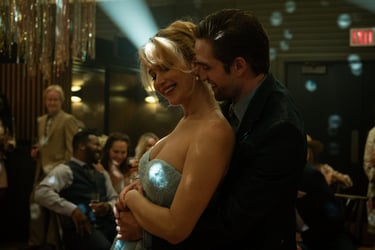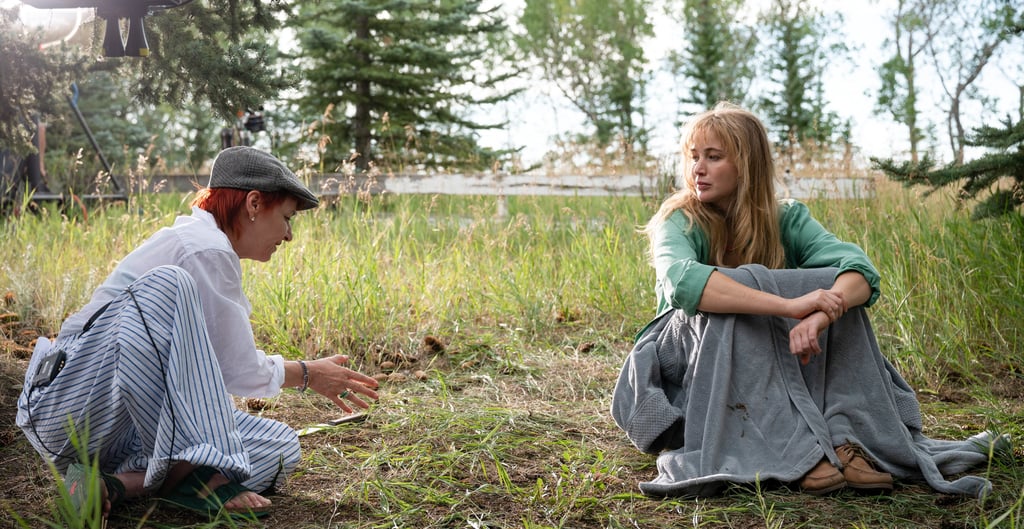Die My Love Cinematographer Seamus McGarvey on Day-for-Night, Ektachrome, and Creating a Fever-Dream World
INTERVIEWS
Belal Abd Elaziz
11/20/2025


Seamus McGarvey, the acclaimed cinematographer behind Die My Love, takes us inside the making of the film, sharing insights into his creative process, the challenges of working with a small crew, and the collaborative effort required to bring Lynne Ramsay’s vision to life.
From shooting on Kodak Ektachrome to creating haunting day-for-night sequences, McGarvey discusses how he crafted the film’s atmospheric, phantasmagorical visuals while working with stars like Jennifer Lawrence and Robert Pattinson and navigating the unique challenges of working with animals and infants on set.
So I want to know, what was the hardest shot for you in the film?
Every shot is considered and, to an extent, difficult. But the lovely thing about working within a team is the shared responsibility. If something isn’t working, or you find yourself thinking, “I can’t work out how to do this,” you can rely on the people around you to help you achieve it. That collaborative aspect is one of the things I love most about filmmaking. You’re never alone — you’re surrounded by people who can help you problem-solve and push the creativity forward.
As a director of photography, you’re always trying to push a particular look, and ultimately the responsibility is yours, but you still depend on others to help achieve what the director wants.
On Die My Love, there were many challenges. We shot on Kodak Ektachrome E100, worked with animals like small dogs, and had the privilege, and challenge, of working with babies. Their hours are extremely limited, so you must adapt your schedule around them. We worked with twins: Victoria and Kennedy Calderwood. Victoria would film first, and once her hours were done, just a couple per day, her sister would step in.
All of this required us, along with the assistant director, producers, and the whole team, to shape each day around the limitations and realities of what we had to work with.
When you read the script, was there a specific moment that made you think, “I can’t wait to shoot this scene”?
Lynn Ramsey called me and said, “Martin Scorsese just called, he wants me to do a film he’s producing.” It was wonderful reading the script for the first time, especially knowing that having worked with Lynne before on We Need to Talk About Kevin, this was going to be a real departure from the words on the page, something shaped by her imagination, something entirely different. I could immediately see how it could be transformed through her eyes.
She also told me about the actors she would be working with, Jennifer Lawrence, Robert Pattinson, and Sissy Spacek, and it truly was an extraordinary experience working with actors of that caliber.
Do you recall any moments from the set while working with Jennifer, Robert, or Sissy?
They were really amazing because, despite being some of the biggest Hollywood stars, on this film, which was quite low-budget, they didn’t demand any kind of star treatment. Working with them was a real privilege and joy. For example, when Rob wasn’t on set and we were shooting Jennifer, he would be upstairs reading a book. There was none of that usual “we have to fetch someone from their trailer and it’ll take 45 minutes for them to get on set.” They were right there, which was incredibly important because, on a low-budget film, time is of the essence. We didn’t have many days to shoot, and we didn’t have a lot of money.
It was a memory of working with actors who are also filmmakers and truly understand the constraints of a budget. They’re used to working with millions of dollars, but this was not that kind of film, and they adapted, fully committed to the movie. That kind of dedication is something I’ll never forget.
The film is really depressing. Was the mood on set similar, or was it different while you were filming?
If you ask Lynne Ramsay the same question, she would say the film is a comedy. She tried to make it a comedy, but it’s also about mental health, depression, and dreams that don’t always go the way you want them to.
So yes, there are depressive moments, and certainly there’s a pervasive darkness throughout the film. But sometimes that darkness can be uplifting in a paradoxical way. You can depict depression and madness on screen, and it can carry a strangely uplifting quality.
Did you have to put yourself inside Jennifer’s character to shape the film’s visuals, especially considering her mental state?
That’s a really good question. There was definitely an element of all of us going a bit mad, because we were working in very tight quarters. The crew was small, and the subject matter itself was intense. When you’re in such close proximity, there’s a merging of fiction and reality.
For someone like myself, just a crew member filming someone as extraordinary as Jennifer, there’s a certain atmosphere of madness that can build, an almost osmotic effect where the intensity in the air affects everyone. Yes, that was certainly the case on this shoot.
When you first started reading the script, how did you imagine the film would look, and did the final version turn out the way you envisioned?
Well, it was never entirely my vision, cinematographically speaking, and it never is. Whenever I work with a director, I bring my perspective, but I merge it with the director’s vision, the writer’s script, the production designer, costume department, and all the other departments. There’s a kind of democratic exchange of ideas that ultimately contributes to the director’s vision.
That said, I did have a few broad-stroke notions about the cinematography that I brought to the table, and Lynn was excited by them, particularly the idea of using Ektachrome. She loved it because she started as a cinematographer before moving into directing, so she understood the value of that. In fact, in one of her earlier films, Morvern Callar, she had used Ektachrome for some scenes.
I suggested using Ektachrome to depict an idyllic, nostalgic, somewhat happy scenario that gradually becomes corroded. Ektachrome has a way of capturing what’s in front of you, but the film stock itself alters the image, creating a subtle shift from reality. I liked that quality. It was perfect because it allowed me to light interiors in a way I wouldn’t have if we were shooting digitally or on negative stock. The result was a peculiar, singular look.
When we did the Digital Intermediate and the colorist worked on grading, they said, “We should just go with this look — it’s so unique you can’t fully emulate it digitally.” There’s something intrinsic in Ektachrome that brings a shift away from reality.
Another early, broad-stroke decision was to shoot Day or Night — so-called “deaf or night” photography. We were working with babies, so shooting at night was nearly impossible, especially in the Canadian summertime, where there’s almost no darkness for three or four hours.
The daylight scenes were so beautiful in this film, so how did you manage to do that?
Thank you for saying that. I love day-for-night photography. I’ve used it on a few films because it lends a sense of surreality. I’m also inspired by the photography of Edward Steichen, a 1920s pictorialist who used a technique called cyanotype. That was a big influence for us.
It also connected to Grace, Jennifer Lawrence’s character, and her postpartum depression, the way days and nights, sleeplessness and wakefulness, merge and become circular. That fascinated me, because it gave a real sense of artificiality and madness. To capture this, I created filters from clear glass, darkened with candle smoke, which I placed in the matte box. I would then paint out specific parts of the image, leaving the sky black around it. I avoided standard 85 filters that immediately turn everything blue and instead introduced cyan and green tones directly into the image, creating a fever-dream, nocturnal landscape.
Another major decision was the aspect ratio. We were shooting in Calgary, Canada, which was standing in for Montana, USA. Despite the vast landscapes, Lynn and I chose a more boxy, Academy ratio of 1.33:1 to create a sense of claustrophobia within the openness. The film is full of individual portraits, which reinforced a feeling of separation. There are very few two-shots of Rob and Jennifer as Grace and Jackson; the focus tends to remain on her.
We used vintage Panavision lenses for most shots, along with a special Petzval lens from the 1920s. It produces a sharp central image surrounded by a swirling, out-of-focus bouquet, a beautiful, unique effect that conveys the turbulence of someone’s mind.
With most of the story unfolding in a single location between only two characters, how did you tackle the challenge of keeping the visuals dynamic and the audience engaged?
I think people are used to seeing films that are very fast-paced, quick-cut, and zippy. But ultimately, when you’re creating an atmosphere, which we wanted to be very strong, phantasmagorical, and ghostly, the goal is to draw the audience in. You rely on great performers like Jennifer Lawrence and Robert Pattinson to help create that atmosphere.
It’s less about jolting the audience awake, like a fairground ride, and more about luring them into a world where they project their own sensibilities, trials, and emotions onto the screen. That connection, the suture, the stitch, is what engages them, rather than flashy shots designed to elicit an immediate “wow” moment with a piece of popcorn.
I’d like to talk about the film’s final scene, the fire sequence where she walks in naked. It actually reminded me a bit of the ending of Robert Eggers’ The Witch, if you’ve seen it. How did you approach shooting that scene?
Obviously, we couldn’t burn down a forest and have one of the greatest actresses in the world walking through it naked. We were greatly aided by a fantastic visual effects department, who created that shot.
We shot the scene day-for-night in the forest. It’s a nighttime scene, but we filmed it during the day and used a lot of interactive lighting, big tungsten lights, warm, dimming, and flickering, so the forest appeared to glow as if it were on fire, even though there were no actual flames. Afterwards, we shot plates of fire on trees, which could then be composited into the scene using visual effects.
The entire sequence, including the top shot of the burning forest, was created this way ensuring that no real forest was harmed.


